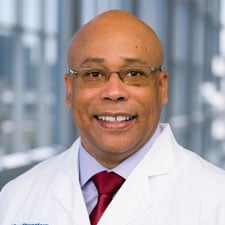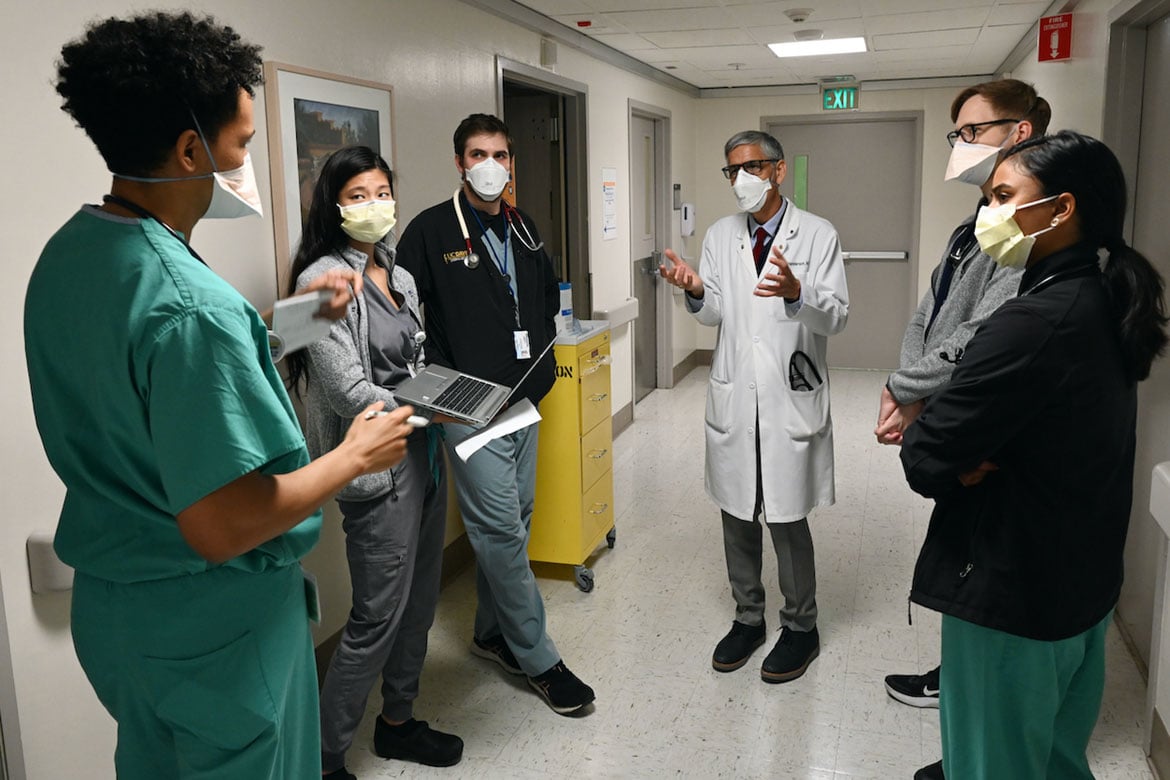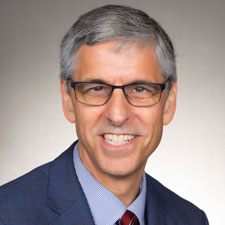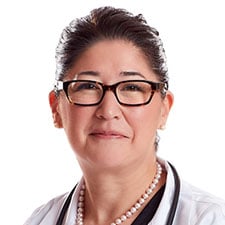Projections from the Association of American Medical Colleges (AAMC) anticipate a massive shortage of physicians in the U.S. within 12 years.
At the same time, however, the most recent data from the AAMC shows that the physician workforce does not look like the nation’s increasingly diverse patient population:
- Hispanic people make up 18.5% of the U.S. population, but only 5.8% of the physician workforce.
- Black people are 13.4% of the population, but 5% of the physician workforce.
- Native Americans or Alaska Natives make up 1.3% of the U.S. population, but 0.3% of physicians.
With these figures in mind, can building a more diverse physician workforce help address the projected shortage?
“That’s an easy ‘yes,’ because there are segments of our population that have traditionally had many more hurdles to clear to become a physician,” said Quinn Capers IV, MD, associate professor for faculty diversity and vice chair for diversity and inclusion with the department of internal medicine at the University of Texas (UT) Southwestern Medical School in Dallas.
“When you look at the current racial and ethnic makeup of physicians in the United States, it doesn't come close to mirroring or reflecting the wonderful diversity that we have in this country,” said Dr. Capers, an interventional cardiologist. “We could help with the physician shortage right there, if we just extended an equal opportunity to become a physician to all demographic groups.”
Like other proposed solutions to the physician shortage, however, so much also depends on relieving the bottleneck of graduate medical education (GME) slots to train the growing number of medical school graduates.
“If you're just talking numbers and getting more physicians because we have a physician shortage, yes, diversifying medicine could certainly help with that,” Dr. Capers said. “But we can't do it alone. We need things like more residency slots.”
Support for 14,000 new GME slots
The U.S. faces a projected shortage of between 37,800 and 124,000 physicians within 12 years, according to The Complexities of Physician Supply and Demand: Projections From 2019 to 2034 (PDF), a report released by the AAMC.
Recent data from the AAMC suggests that medical and osteopathic schools are stepping up to both boost their enrollment and diversify their student bodies.
Black students made up 11.3% of first-year medical students in 2021, up from 9.5% in 2020, according to the AAMC. Of particular note are the increases among Black men; after decades of stagnation, first-year students from this group increased by 20.8%.
Hispanic students represented 12.7% of matriculants, up from 12% in 2020. Native Americans or Alaska Native first-year students, however, declined by 8.5%, to 227, making up only 1% of matriculants.
But these students must eventually find a residency. There were 149,200 active residents and fellows in training during the 2020–2021 academic year, which was 2.9% more than the previous year, according to the Accreditation Council for Graduate Medical Education.
But the number of Medicare-funded residency positions in which new doctors can train has been flat since the Balanced Budget Act of 1997 capped the number of positions within existing programs. Despite demand, growth has crept forward at rates below 3%. Limited growth has come from federal funding of programs at new teaching hospitals and the Teaching Health Center GME program created by the Affordable Care Act. Additional support has come from states and individual hospitals.
In addition, funding for 1,000 new Medicare-supported GME slots was included in the $2.3 trillion Consolidated Appropriations Act of 2021.
The AMA and AAMC are members of the Graduate Medical Education Coalition that supports the bipartisan “Resident Physician Shortage Reduction Act of 2021” (PDF), which would gradually provide 14,000 new Medicare-supported GME positions. The AMA’s SaveGME.org website explains how GME funding helps resident physicians provide care to patients underserved by the health system, advance clinical research and create the future of medicine.
Faster path to practice can help
The University of California, Davis, School of Medicine is addressing the physician shortage on several fronts. This includes recruiting a more diverse student population, offering an accelerated six-year path to practice, and focusing on training primary care doctors for practice in rural and other underserved communities.
UC Davis is a member of the AMA Accelerating Change in Medical Education Consortium that promotes developing flexible, competency-based pathways—tailoring the time required in medical school to the ability and clinical background of the student.
UC Davis’ Accelerated Competency-based Education in Primary Care (ACE-PC) program is operated in partnership with Kaiser Permanente Northern California, with direct progression into affiliated UC Davis or Kaiser Permanente primary care residency programs, where they do rotations in their first and third years of medical school.
A second UC Davis program was supported with an AMA Accelerating Change in Medical Education grant from 2013–2018. UC Davis has since received an AMA Reimagining Residency grant for the California Oregon Medical Partnership to Address Disparities in Rural Education and Health (COMPADRE) which is a collaboration with Oregon Health & Science University that includes 10 health systems, 10 institutional sponsors and federally qualified health centers to address workforce shortages in disadvantaged communities between Sacramento and Portland.
Only 9.6% of incoming freshmen at the UC Davis School of Medicine in 2006 included students from historically excluded racial and ethnic groups. In 2008, UC Davis implemented a new holistic review for admissions and the total jumped to 19.4% in 2009, and reached 52% in 2020.
“About 15 years ago, when we embarked on this journey, we were really focused on trying to eventually get to a place where our student population was more reflective of California's population,” said Mark C. Henderson, MD, associate dean for admissions and outreach at the UC Davis School of Medicine.
“The fundamental reason for why we do this work is health equity,” said Dr. Henderson, an internist and AMA member. “We've seen in our own personal development as physicians that who you take care of—and how you are trained to take care of them—are critically important to improving the health of the entirety of society.”
Tonya Fancher, MD, MPH, agreed.
“What we’ve wondered for a long time is how do we take care of everyone?” said Dr. Fancher, an internist and AMA member who is the UC Davis associate dean for workforce innovation and education quality improvement. “In our commitment to take care of everyone, we’ve thought about diversity as key to that.”
Early in the pandemic, the shortage of Latino physicians was acutely felt by Latino workers who are disproportionately employed in fields considered essential work. “Latinos are at the forefront of this pandemic,” said the 2020 report from the UCLA Latino Policy & Politics Initiative.
When a Spanish-speaking patient has a physician who also speaks Spanish, “the patient is more likely to report improved interpersonal processes, satisfaction, and greater health outcomes,” the report noted.
Drs. Henderson and Fancher identified primary care as the health system’s greatest need and noted that one of the quickest and most efficient ways to elevate the health of historically underserved communities is to bring in primary care physicians.
“We think about medical schools as the gatekeepers—we are determining the future health workforce,” said Dr. Fancher. “That is a gigantic responsibility that we have to really take very seriously.”
The school’s work in this area has been noticed. In the recent rankings of the nation’s medical schools by U.S. News & World Report, UC Davis tied with another as the third-most diverse medical school in the nation and the eighth-best school for primary care.
According to the figures provided to U.S. News & World Report:
- 58.1% of UC Davis’ 2019–2021 graduates entered primary care specialties.
- 40% of their medical students came from racial and ethnic groups historically excluded from medicine.
- 22% are practicing in communities with limited access to health care.
“Students and future physicians who come from communities that have been affected by the lack of primary care physicians or affected by health inequities baked into the system—based on class, race or neighborhood—they are much more likely to want to pursue a career in those communities and to make a difference,” Dr. Henderson said. “Typically, that means doing primary care.”
To find these students, UC Davis recruitment efforts give attention to an often-overlooked pool of applicants: those who have attended community colleges.
“We know that students who go to community college tell us that they are more likely to do primary care,” and to do so in communities that have been underserved by limited access to health care, said Dr. Fancher. “But when community college courses show up on your transcript, it traditionally is looked at as a negative factor in admissions. So, if we're trying to address the primary care physician shortage, we need to change that.
“What we're trying to do is identify students at the community-college level to help them stay on this path to medicine, prepare them for medical school, and help them maintain that desire to do primary care and to work with their communities,” she added.
A 2015 AAMC analysis (PDF) noted the propensity of medical students from historically excluded racial and ethnic groups to practice in primary care specialties.
For physicians who graduated between 1980 and 2007, those who practiced in primary care included:
- 41.6% of Black physicians.
- 44% of Native American and Native Alaskan physicians.
- 36.5% of Hispanic physicians.
In comparison, 32.3% of white medical school graduates went into primary care specialties.
Medical students from historically excluded racial and ethnic groups “have been shown as major contributors to the primary care physician workforce in the United States,” the AAMC analysis concluded. If more of these students “enrolled in medicine, it will hold significance for the supply of primary care physicians.”
To-do list to diversify medicine
Programs to boost diversity in medical school have been in place for years, but the results have been limited, according to a 2019 study published in JAMA Network Open by researchers from the University of Pennsylvania.
They found that “from 2002 to 2017, numbers and proportions of Black, Hispanic, and Native Americans or Alaska Native medical school matriculants increased, but at a rate slower than their age-matched counterparts in the U.S. population.”
This point was echoed in a 2021 report from the AMA Council on Medical Education (PDF), which cites the study’s findings.
Among the report’s many recommendations adopted by the AMA House of Delegates are ones that call on the AMA to:
- Recognize the harm caused by the 1910 Flexner report to historically Black medical schools, the diversity of the physician workforce, and the outcomes of patients from historically marginalized racial and ethnic groups.
- Advocate funding to support the creation and sustainability of medical schools and residency programs affiliated with historically Black colleges and universities, Hispanic-serving institutions and tribal colleges and universities, with the goal of achieving a physician workforce that mirrors the racial, ethnic and gender composition of the U.S. population.
- Work with appropriate stakeholders to study reforms to mitigate demographic and socioeconomic inequities in the residency and fellowship selection process, including but not limited to the selection and reporting of honor society membership and the use of standardized tools to rank applicants.
Delegates also amended existing AMA policy to encourage:
- The development of evidence-informed programs to build role models among academic leadership and faculty for the mentorship of students, residents and fellows underrepresented in medicine and in specific specialties.
- Physicians to engage in their communities to guide, support and mentor high school and undergraduate students with a calling to medicine.
- Medical schools, health care institutions, managed care and other appropriate groups to develop policies that articulate the value and importance of diversity as a goal that benefits all participants, cultivate and fund programs that nurture a culture of diversity on campus, and recruit faculty and staff who share this goal.
- The federal departments of Education and Labor to develop policies and initiatives in support of students from marginalized backgrounds that decrease the educational opportunity gap, increase participation in high school advanced-placement courses, and increase the high-school graduation rate.
The AMA Accelerating Change in Medical Education Consortium has worked with the Morehouse School of Medicine and other member medical schools to share strategies for enhancing recruitment, fostering viable pathways into medicine, promoting holistic admissions processes and creating inclusive learning environments.
The group also has shared a process of institutional diversity and inclusion self-study (PDF) and issued a statement to protect diverse learners during educational disruptions related to COVID-19.
Learn more about the AMA’s efforts to diversify the physician workforce.
Less debt, more diversity
“The costs of medical education should never be a barrier to the pursuit of a career in medicine nor to the decision to practice in a given specialty,” says AMA policy.
The AMA fights to ease young doctors’ financial burdens given that medical students typically graduate with about $200,000 in medical student-loan debt. That debt load contributes to physician shortages in rural and other areas underserved by limited access to health care because it helps drive new physicians to seek higher-paying positions in larger cities.
Among other steps, the AMA supports the bipartisan “Resident Education Deferred Interest Act” that would allow borrowers to qualify for interest-free deferment on student loans while serving in a medical or dental internship or residency program. Learn more about how Congress can save resident physicians $12,000 a year.
Accelerated medical school programs based on competency rather than time can cut tens of thousands of dollars of potential student-loan debt, allowing more new doctors to choose primary care specialties, and removing barriers for students from low-income families to attend medical school.
Anticipated debt is a deterrent for applying to medical school, according to a 2013 study published in PLoS One.
“The literature has established that high medical student debt has frustrated efforts to create a diverse and representative physician workforce,” the authors wrote. “The cost of medical education has also been shown to deter qualified Black and Hispanic applicants, in particular.”
They also noted that “Black students had higher debt burdens than their counterparts from other racial and ethnic backgrounds. It is plausible that this disproportionate debt burden may play a role in the decline in medical school attendance among Black students.”
The UC Davis ACE-PC program was launched with six students in 2014. The inaugural graduates are practicing in community-based primary care settings, in geriatrics, at Kaiser Permanente, and another is pursuing a nephrology fellowship, according to the school’s website.
As of 2021, 53 students have completed the program prior to entering residency training in a primary care specialty. Six more will graduate in May.
Eighty percent are the first in their family to go to college, 75% are Black or Hispanic, and 75% are women. Most are older than the typical medical student and all are committed to helping the communities they are from.
ACE-PC “is a way to be more urgent and more intentional about the fact that more primary care is needed, but it's also highly connected to diversity,” Dr. Henderson said. “So, it’s fundamentally a diversity-enhancement program as well.”
“The change we’ve seen at UC Davis School of Medicine is really incredible,” he said. “The first time I lectured to the class, the vast majority of students were white—but now things are completely reversed, and most are students of color. And it’s a welcome change indeed.”
This change is also celebrated in a tweet from the medical school with class pictures of 1972 and 2022 graduates that shows the growth in the size and diversity of their program.
Need for a shake-up
A 2006 study by the Association of Black Cardiologists identified 185 institutions receiving federal funding for their cardiology training programs and found that one-quarter had yet to graduate their first Black cardiologist. This roster included The Ohio State University (OSU) Wexner Medical Center, where cardiovascular medicine chief William Abraham, MD, made it a priority to get off the list.
“That shook him—in a good way” to take concrete steps, said Dr. Capers, who joined OSU in 2007 as an assistant professor of medicine and associate dean for admissions.
The actions taken at OSU led to matching fellows from historically excluded racial and ethnic groups “for five consecutive years and may be suitable for adoption or adaptation by other programs,” Dr. Capers and colleagues wrote in the Journal of Graduate Medical Education.
“Most of it was aggressive recruiting, aggressively reaching out to minority individuals to let them know that Ohio State's a place where you can get great cardiology training,” Dr. Capers said.
Also, discussion of racial health inequities was added to curriculum and lectures, which drew much interest.
“It tends to be very important to physicians of diverse backgrounds,” Dr. Capers said. “They tend to really have a legacy of wanting very hard to try to eliminate health care disparities. So simply having that as a topic of discussion in your training program is a draw and a recruiting tool to have diverse individuals want to come to your program.”
In the Journal of Graduate Medical Education report, Dr. Capers cited AAMC data that only 3.5% of the 11,097 practicing cardiologists were Black. This figure was mirrored by the percentage of Black cardiology fellows: 4.3%.
Ohio State had not helped boost this total as—from 1967 to 2007—it had never trained a single cardiologist fellow from a racial or ethnic group historically excluded from medicine. After the first such fellow entered the program in 2007, the number steadily grew and accounted for 25% of the program in 2011 (four out of 16).
United States Medical Licensing Examination (USMLE) “score comparison shows no significant difference between” fellows that have been historically excluded from medicine and other fellows “matched to the OSU program,” according to Dr. Capers.
Later, in activities separate from those when he led the selection of cardiology trainees and in his role as the OSU College of Medicine’s associate dean of admissions, Dr. Capers urged members of the admissions committee to look beyond an applicant’s performance on standardized tests scores.
Admissions-committee members also underwent annual implicit-bias mitigation training. Such efforts helped contribute to increasing the share of Ohio State medical students from racial and ethnic groups historically excluded from medicine by 23%—from 30 to 37 students—in just one year, according to a 2017 Academic Medicine study on which Dr. Capers was the lead author.
“This holistic review of applicants resulted in classes with average standardized test scores that were the same or higher than previous years as student body diversity grew,” Dr. Capers said.
Now in charge of recruiting a diverse faculty at UT Southwestern, Dr. Capers said it’s necessary to overcome the inertia that keeps the same admissions process in place year after year.
“This is not a fad—it’s here to stay,” he said. “There is a need to diversify medicine, and I think people are really starting to get that now.”
At UT Southwestern, all 33 of the medical departments have someone designated as its leader for diversity and equity, and they are compensated for their time.
“This is not volunteer work,” Dr. Capers said.
Growing a more diverse physician workforce must start early, he said, and there’s a need for younger students to see role models who came from the same background they did
The AMA Doctors Back to School™ program, for example, introduces children to professional role models and shows kids of all ages from historically excluded racial and ethnic groups that a career in medicine is attainable.
Dr. Capers hailed the impact of such outreach and called for more.
“You have to go back to elementary school to get kids excited about science, but—almost as important as getting them excited about science—is having them understand that being a doctor is realistic,” Dr. Capers said. “You can do this. You can be a doctor. Here's someone that comes from your community, who has faced all the hurdles that you face, and he or she is a physician. If they did it, you can too.”







